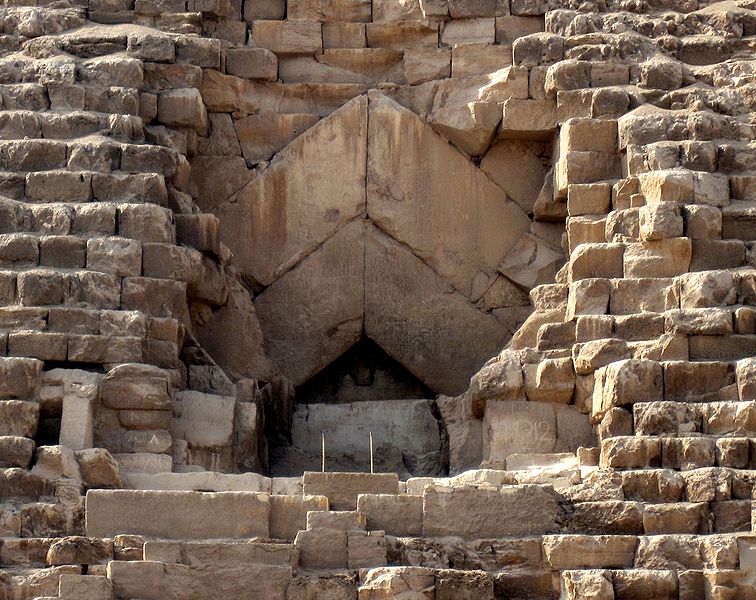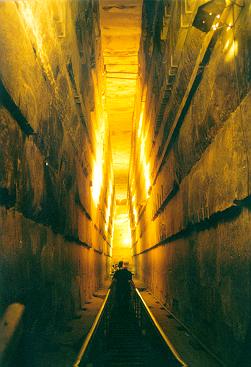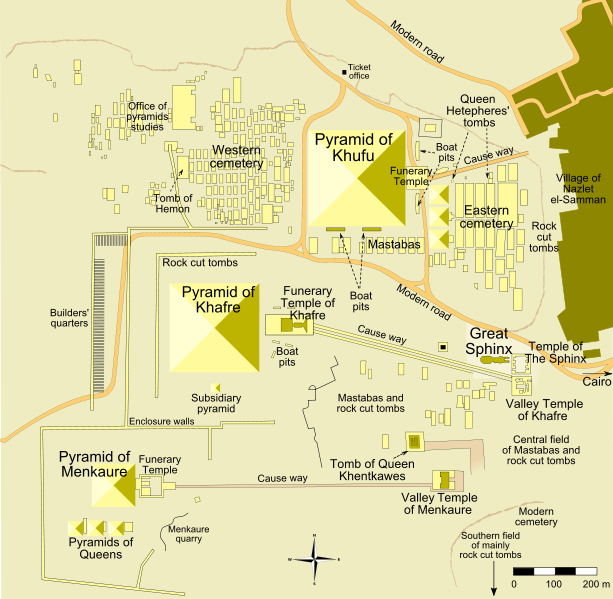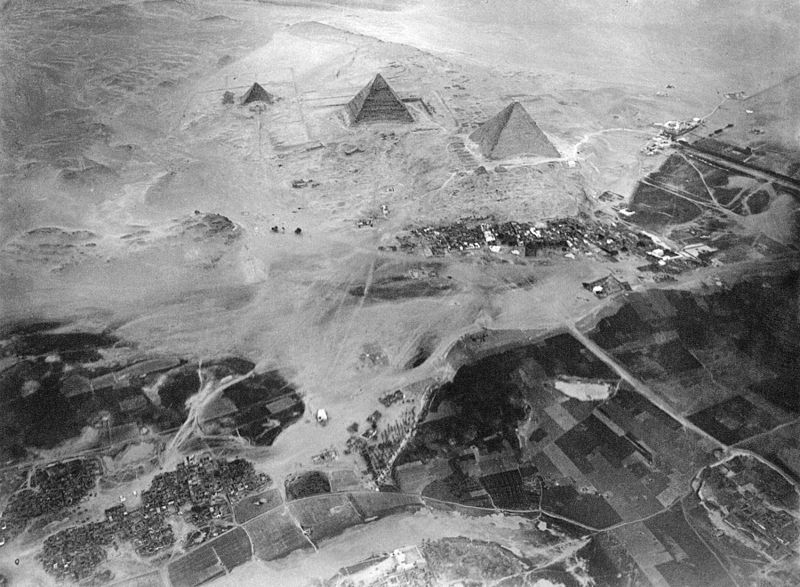<Back to Index>
- Giza Necropolis, Egypt Pyramid of Cheops, 2550 B.C.
PAGE SPONSOR
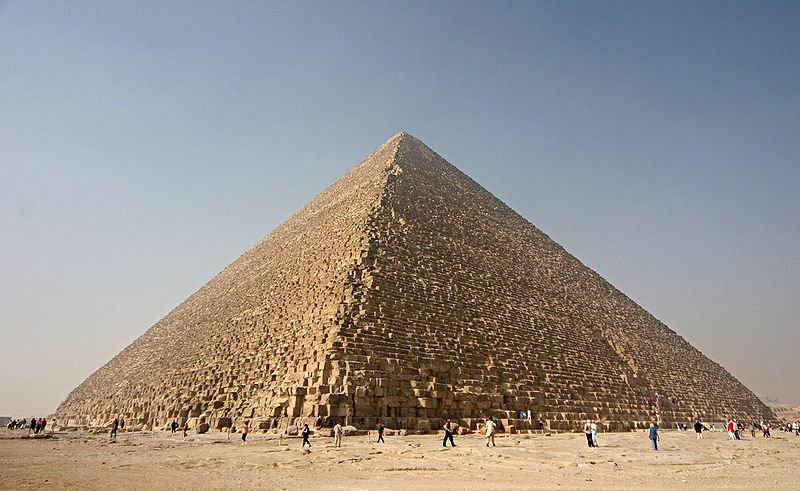
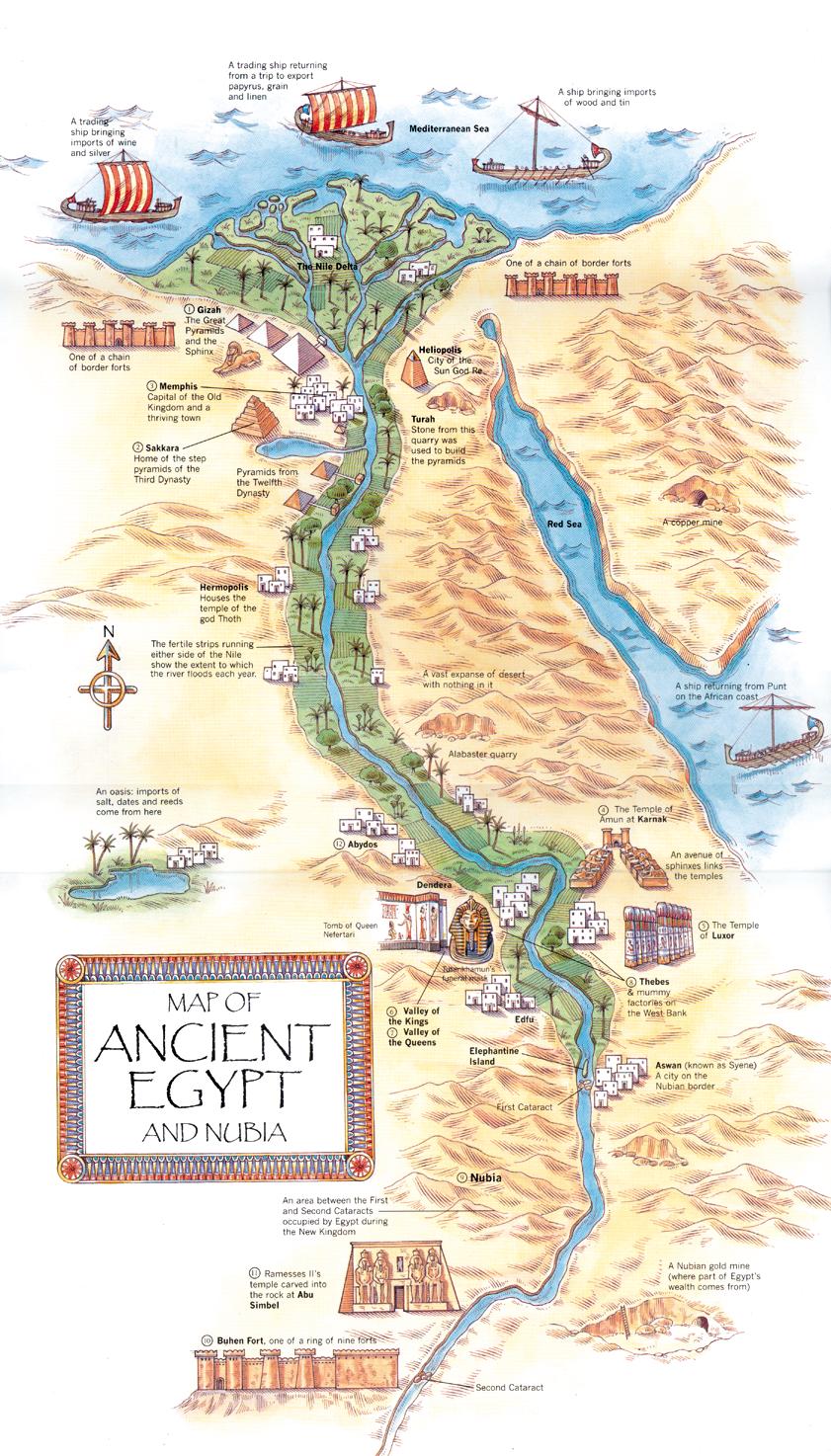
The Great Pyramid of Giza (called the Pyramid of Khufu and the Pyramid of Cheops) is the oldest and largest of the three pyramids in the Giza Necropolis bordering what is now El Giza, Egypt. It is the oldest of the Seven Wonders of the Ancient World, and the only one to remain largely intact. Egyptologists believe that the pyramid was built as a tomb for fourth dynasty Egyptian Pharaoh Khufu (Cheops in Greek) over an approximately 20 year period concluding around 2560 BC. Initially at 146.5 meters (480.6 ft), the Great Pyramid was the tallest man made structure in the world for over 3,800 years, the longest period of time ever held for such a record. Originally, the Great Pyramid was covered by casing stones that formed a smooth outer surface; what is seen today is the underlying core structure. Some of the casing stones that once covered the structure can still be seen around the base. There have been varying scientific and alternative theories about the Great Pyramid's construction techniques. Most accepted construction hypotheses are based on the idea that it was built by moving huge stones from a quarry and dragging and lifting them into place.
There are three known chambers inside the Great Pyramid. The lowest chamber is cut into the bedrock upon which the pyramid was built and was unfinished. The so - called Queen's Chamber and King's Chamber are higher up within the pyramid structure. The Great Pyramid of Giza is the only pyramid in Egypt known to contain both ascending and descending passages. The main part of the Giza complex is a setting of buildings that included two mortuary temples in honor of Khufu (one close to the pyramid and one near the Nile), three smaller pyramids for Khufu's wives, an even smaller "satellite" pyramid, a raised causeway connecting the two temples, and small mastaba tombs surrounding the pyramid for nobles.
It is believed the pyramid was built as a tomb for fourth dynasty Egyptian pharaoh Khufu and was constructed over a 20 year period. Khufu's vizier, Hemon, or Hemiunu, is believed by some to be the architect of the Great Pyramid. It is thought that, at construction, the Great Pyramid was originally 280 Egyptian cubits tall, 146.5 meters (480.6 ft) but with erosion and absence of its pyramidion, its present height is 138.8 meters (455.4 ft). Each base side was 440 royal cubits, 230.4 meters (755.9 ft) long. A royal cubit measures 0.524 meters. The mass of the pyramid is estimated at 5.9 million tonnes. The volume, including an internal hillock, is roughly 2,500,000 cubic meters. Based on these estimates, building this in 20 years would involve installing approximately 800 tonnes of stone every day. Similarly, since it consists of an estimated 2.3 million blocks, completing the building in 20 years would involve moving an average of more than 12 of the blocks into place each hour, day and night. The first quasi - precision measurements of the pyramid were done by Egyptologist Sir Flinders Petrie in 1880 – 82 and published as The Pyramids and Temples of Gizeh. Almost all reports are based on his measurements. Many of the casing stones and inner chamber blocks of the Great Pyramid were fit together with extremely high precision. Based on measurements taken on the north eastern casing stones, the mean opening of the joints is only 0.5 millimeters wide (1/50th of an inch). It should be noted, however, that Dr. Petrie did admit his measurements were calculated, not actually viewed, due to the tons of debris making direct viewing of the pyramid base impossible. Direct viewing of the base did eventually occur, when Professor Borchardt of the German Institute of Egyptian Archeology had the pyramid base cleared, for the James Cole survey of 1925, "Determination of the Exact Size and Orientation of the Great Pyramid of Giza, SURVEY of EGYPT Paper #39."
The pyramid remained the tallest man - made structure in the world for over 3,800 years, unsurpassed until the 160 meter tall spire of Lincoln Cathedral was completed c. 1300. The accuracy of the pyramid's workmanship is such that the four sides of the base have an average error of only 58 millimeters in length. The base is horizontal and flat to within ±15 mm. The sides of the square base are closely aligned to the four cardinal compass points (within 4 minutes of arc) based on true north, not magnetic north, and the finished base was squared to a mean corner error of only 12 seconds of arc. The completed design dimensions, as suggested by Petrie's survey and subsequent studies, are estimated to have originally been 280 cubits high by 440 cubits long at each of the four sides of its base. The ratio of the perimeter to height of 1760/280 cubits equates to 2π to an accuracy of better than 0.05% (corresponding to the well known approximation of π as 22/7). Some Egyptologists consider this to have been the result of deliberate design proportion. Verner wrote, "We can conclude that although the ancient Egyptians could not precisely define the value of π, in practice they used it". Petrie, author of Pyramids and Temples of Gizeh concluded: "but these relations of areas and of circular ratio are so systematic that we should grant that they were in the builder's design". Others have argued that the Ancient Egyptians had no concept of pi and would not have thought to encode it in their monuments. The creation of the pyramid slope may instead be based on the run length of the base side of a right triangle into a constant 1 RC (royal cubit) rise (the seqed).
The Great Pyramid consists of an estimated 2.3 million limestone blocks with most believed to have been transported from nearby quarries. The Tura limestone used for the casing was quarried across the river. The largest granite stones in the pyramid, found in the "King's" chamber, weigh 25 to 80 tonnes and were transported from Aswan, more than 500 miles away. Traditionally, ancient Egyptians cut stone blocks by hammering wooden wedges into the stone which were then soaked with water. As the water was absorbed, the wedges expanded, causing the rock to crack. Once they were cut, they were carried by boat either up or down the Nile River to the pyramid. It is estimated that 5.5 million tons of limestone, 8,000 tons of granite (imported from Aswan), and 500,000 tons of mortar were used in the construction of the Great Pyramid.
At
completion, the Great Pyramid was surfaced by white "casing
stones" – slant - faced, but flat - topped, blocks of highly polished
white limestone. These were carefully cut to what is approximately a face slope with a seked of
5½ palms to give the required dimensions. Visibly, all that
remains is the underlying stepped core structure seen today. In
AD 1300, a massive earthquake loosened many of the outer casing
stones, which were then carted away by Bahri Sultan An-Nasir Nasir - ad - Din al - Hasan in 1356 to build mosques and fortresses in nearby Cairo.
The stones can still be seen as parts of these structures. Later
explorers reported massive piles of rubble at the base of the pyramids
left over from the continuing collapse of the casing stones, which were
subsequently cleared away during continuing excavations of the site.
Nevertheless, a few of the casing stones from the lowest course can be
seen to this day in situ around the base of the Great Pyramid, and
display the same workmanship and precision as has been reported for
centuries. Petrie also found a different orientation in the core and in
the casing measuring 193 centimeters ± 25 centimeters. He
suggested a redetermination of north was made after the construction of
the core, but a mistake was made, and the casing was built with a
different orientation. Petrie
related the precision of the casing stones as to being "equal to
opticians' work of the present day, but on a scale of acres" and "to
place such stones in exact contact would be careful work; but to do so
with cement in the joints seems almost impossible". It
has been suggested it was the mortar (Petrie's "cement") that made this
seemingly impossible task possible, providing a level bed which enabled
the masons to set the stones exactly.
Many alternative, often contradictory, theories have been proposed regarding the pyramid's construction techniques. Many disagree on whether the blocks were dragged, lifted, or even rolled into place. The Greeks believed that slave labor was used, but modern discoveries made at nearby worker's camps associated with construction at Giza suggest it was built instead by tens of thousands of skilled workers. Verner posited that the labor was organized into a hierarchy, consisting of two gangs of 100,000 men, divided into five zaa or phyle of 20,000 men each, which may have been further divided according to the skills of the workers.
One mystery of the pyramid's construction is its planning. John Romer suggests
that they used the same method that had been used for earlier and later
constructions, laying out parts of the plan on the ground at a 1 to 1
scale. He writes that "such a working diagram would also serve to generate the architecture of the pyramid with precision unmatched by any other means." He also argues for a 14 year time span for its construction.
The original entrance to the Great Pyramid is 17 meters (56 ft) vertically above ground level and 7.29 meters (23.9 ft) east of the center line of the pyramid. From this original entrance there is a Descending Passage .96 meters (3.1 ft) high and 1.04 meters (3.4 ft) wide which goes down at an angle of 26° 31'23" through the masonry of the pyramid and then into the bedrock beneath it. After 105.23 meters (345.2 ft) the passage becomes level and continues for an additional 8.84 meters (29.0 ft) to the lower Chamber, which appears not to have been finished. There is a continuation of the horizontal passage in the south wall of the lower chamber; there is also a pit dug in the floor of the chamber. Some Egyptologists suggest this Lower Chamber was intended to be the original burial chamber, but Pharaoh Khufu later changed his mind and wanted it to be higher up in the pyramid.
At 28.2 meters (93 ft) from the entrance is a square hole in the roof of the Descending Passage. Originally concealed with a slab of stone, this is the beginning of the Ascending Passage. The Ascending Passage is 39.3 meters (129 ft) long, as wide and high as the Descending Passage and slopes up at almost precisely the same angle. The lower end of the Ascending Passage is closed by three huge blocks of granite, each about 1.5 meters (4.9 ft) long. At the start of the Grand Gallery on the right - hand side there is a hole cut in the wall (and now blocked by chicken wire). This is the start of a vertical shaft which follows an irregular path through the masonry of the pyramid to join the Descending Passage. Also at the start of the Grand Gallery there is a Horizontal Passage leading to the "Queen's Chamber". The passage is 1.1m (3'8") high for most of its length, but near the chamber there is a step in the floor, after which the passage is 1.73 meters (5.7 ft) high.
The Queen's Chamber is exactly half way between the north and south faces of the pyramid and measures 5.75 meters (18.9 ft) north to south, 5.23 meters (17.2 ft) east to west and has a pointed roof with an apex 6.23 meters (20.4 ft) above the floor. At the eastern end of the chamber there is a niche 4.67 meters (15.3 ft) high. The original depth of the niche was 1.04 meters (3.4 ft), but has since been deepened by treasure hunters.
In the north and south walls of the Queen's Chamber there are shafts, which unlike those in the King's Chamber that immediately slope upwards, are horizontal for around 2m (6') before sloping upwards. The horizontal distance was cut in 1872 by a British engineer, Waynman Dixon, who believed on the analogy of the King's Chamber that such shafts must exist. He was proved right, but because the shafts are not connected to the outer faces of the pyramid or the Queen's Chamber, their purpose is unknown. At the end of one of his shafts, Dixon discovered a ball of black diorite and a bronze implement of unknown purpose. Both objects are currently in the British Museum.
The shafts in the Queen's Chamber were explored in 1992 by the German engineer Rudolf Gantenbrink using a crawler robot of his own design which he called "Upuaut 2". He discovered that one of the shafts was blocked by limestone "doors" with two eroded copper "handles". Some years later the National Geographic Society created a similar robot which drilled a small hole in the southern door, only to find another larger door behind it. The northern passage, which was difficult to navigate because of twists and turns, was also found to be blocked by a door. This research was continued in 2011 by the Djedi Project team.
On 30 May 2011 it was reported in past horizons that after using a Micro snake camera (that can see around corners) the Djedi Project team were able to see all the sides inside the chamber and thus discovered hieroglyphs written in red paint. (The National Geographic Society used a camera that was only able to look straight forward.) They
were also able to scrutinize the inside of the two copper “handles”
embedded in the door, and they now believe it to be of an ornamental
nature. They
also found the reverse side of the “door” to be finished and polished,
which suggests that it wasn’t put there just to fill the shaft, but
rather for a specific reason.
The Grand Gallery continues the slope of the Ascending Passage, but is 8.6 meters (28 ft) high and 46.68 meters (153.1 ft) long. At the base it is 2.06 meters (6.8 ft) wide, but after 2.29 meters (7.5 ft) the blocks of stone in the walls are corbelled inwards by 7.6 centimeters (3.0 in) on each side. There are seven of these steps, so at the top the Grand Gallery is only 1.04 meters (3.4 ft) wide. It is roofed by slabs of stone laid at a slightly steeper angle than the floor of the gallery, so that each stone fits into a slot cut in the top of the gallery like the teeth of a ratchet. The purpose was to have each block supported by the wall of the Gallery rather than resting on the block beneath it, which would have resulted in an unacceptable cumulative pressure at the lower end of the Gallery.
At the upper end of the Gallery on the right - hand side there is a hole near the roof which opens into a short tunnel by which access can be gained to the lowest of the Relieving Chambers. The other Relieving Chambers were discovered in 1837/8 by Colonel Howard Vyse and J.S. Perring, who dug tunnels upwards using blasting powder.
The floor of the Grand Gallery consists of a shelf or step on either side, 51 centimeters (20 in) wide, leaving a lower ramp 1.04 meters (3.4 ft) wide between them. In the shelves there are 54 slots, 27 on each side matched by vertical and horizontal slots in the walls of the Gallery. These form a cross shape that rises out of the slot in the shelf. The purpose of these slots is not known, but the central gutter in the floor of the Gallery, which is the same width as the Ascending Passage, has led to speculation that the blocking stones were stored in the Grand Gallery and the slots held wooden beams to restrain them from sliding down the passage. This, in turn, has led to the proposal that originally many more than 3 blocking stones were intended, to completely fill the Ascending Passage.
At the top of the Grand Gallery there is a step giving onto a horizontal passage approximately 1.02 meters (3.3 ft) long, in which can be detected four slots, three of which were probably intended to hold granite portcullises. Fragments of granite found by Petrie in the Descending Passage may have come from these now vanished doors.
The King's Chamber is 10.47 meters (34.4 ft) from east to west and 5.234 meters (17.17 ft) north to south. It has a flat roof 5.974 meters (19.60 ft) above the floor. 0.91 m (3 ft) above the floor there are two narrow shafts in the north and south walls (one is now filled by an extractor fan to try to circulate air in the pyramid). The purpose of these shafts is not clear: they appear to be aligned on stars or areas of the northern and southern skies, but on the other hand one of them follows a dog - leg course through the masonry so there was not intention to directly sight stars through them. Longtime believed by Egyptologists to be "air shafts" for ventilation, this idea has now been widely abandoned in favor of the shafts serving a ritualistic purpose associated with the ascension of the king’s spirit to the heavens.
The King's Chamber is entirely faced with granite. Above the roof, which is formed of nine slabs of stone weighing in total about 400 tons, are five compartments known as Relieving Chambers. The first four, like the King's Chamber, have flat roofs formed by the floor of the chamber above, but the final chamber has a pointed roof. Vyse suspected the presence of upper chambers when he found that he could push a long reed through a crack in the ceiling of the first chamber. From lower to upper, the chambers are known as "Davidson Chamber", "Wellington Chamber", "Lady Arbuthnot's Chamber" and "Campbell's Chamber". It is believed that the compartments were intended to safeguard the King's Chamber from the possibility of a roof collapsing under the weight of stone above the Chamber. As the chambers were not intended to be seen, they were not finished in any way and a few of the stones still retain mason's marks painted on them. One of the stones in Campbell's Chamber bears a mark, apparently the name of a work gang, which incorporates the only reference in the pyramid to Pharaoh Khufu.
The only object in the King's Chamber is a rectangular granite "sarcophagus", one corner of which is broken. The sarcophagus is slightly larger than the Ascending Passage, which indicates that it must have been placed in the Chamber before the roof was put in place. Unlike the fine masonry of the walls of the Chamber, the sarcophagus is roughly finished, with saw marks visible in several places. This is in contrast with the finely finished and decorated sarcophagi found in other pyramids of the same period. Petrie suggested that such a sarcophagus was intended but was lost in the river on the way north from Aswan and a hurriedly made replacement was used instead.
Today
tourists enter the Great Pyramid via the Robbers' Tunnel dug by workmen
employed by Caliph al-Ma'mun around AD 820. The tunnel is cut straight
through the masonry of the pyramid for approximately 27 meters
(89 ft), then turns sharply left to encounter the blocking stones
in the Ascending Passage. Unable to remove these stones, the workmen
tunneled up beside them through the softer limestone of the Pyramid
until they reached the Ascending Passage. It is possible to enter the
Descending Passage from this point, but access is usually forbidden.
The Great Pyramid is surrounded by a complex of several buildings including small pyramids. The Pyramid Temple, which stood on the east side of the pyramid and measured 52.2 meters (171 ft) north to south and 40 meters (130 ft) east to west, has almost entirely disappeared apart from the black basalt paving. There are only a few remnants of the causeway which linked the pyramid with the valley and the Valley Temple. The Valley Temple is buried beneath the village of Nazlet el-Samman; basalt paving and limestone walls have been found but the site has not been excavated. The basalt blocks show "clear evidence" of having been cut with some kind of saw with an estimated cutting blade 15 ft in length capable of cutting at a rate of 1 1/2 inches (40 mm) a minute. John Romer suggests this "super saw" may have had copper teeth and weighed up to 300 lbs. He theorizes such a saw could have been attached to a wooden trestle and used in conjunction with possibly vegetable oil, cutting sand, or emery or pounded quartz to cut the blocks and would have required at least a dozen men to operate it.
On the south side are the subsidiary pyramids, popularly known as Queens' Pyramids. Three remain standing to nearly full height but the fourth was so ruined that its existence was not suspected until the recent discovery of the first course of stones and the remains of the capstone. Hidden beneath the paving around the pyramid was the tomb of Queen Hetepheres, sister - wife of Sneferu and mother of Khufu. Discovered by accident by the Reisner expedition, the burial was intact, though the carefully sealed coffin proved to be empty.
The Giza pyramid complex, which includes among other structures the pyramids of Khufu, Khafre and Menkaure,
is surrounded by a cyclopean stone wall, the Wall of the Crow, and
outside of which Mark Lehner has discovered a worker's town, otherwise
known as "The Lost City", dated by pottery styles, seal impressions, and
stratigraphy to have been constructed and occupied sometime during the
reigns of Khafre (2520 – 2494 BC) and Menkaure (2490 – 2472 BC). In the early 1970s, the Australian archaeologist Karl Kromer excavated
a mound in the South Field of the plateau. This mound contained
artifacts including mud brick seals of Khufu, which he identified with an
artisans' settlement. Mudbrick
buildings just south of Khufu's Valley Temple contained mud sealings of
Khufu and have been suggested to be a settlement serving the cult of
Khufu after his death. A
workers cemetery used at least between Khufu's reign and the end of the
Fifth Dynasty was discovered south of the Wall of the Crow by Zahi Hawass in 1990.
There are three boat shaped pits around the pyramid, of a size and shape to have held complete boats, though so shallow that any superstructure, if there ever was one, must have been removed or disassembled. In May 1954, the Egyptian archaeologist Kamal el-Mallakh discovered a fourth pit, a long, narrow rectangle, still covered with slabs of stone weighing up to 15 tons. Inside were 1,224 pieces of wood, the longest 23 meters (75 ft) long, the shortest 10 centimeters (0.33 ft). These were entrusted to a native boat builder, Haj Ahmed Yusuf, who slowly and methodically worked out how the pieces fit together. The entire process, including conservation and straightening of the warped wood, took fourteen years.
The
result is a cedar-wood boat 43.6 meters (143 ft) long, its timbers
held together by ropes, which is now currently housed in a special
boat shaped, air conditioned museum beside the pyramid. During
construction of this museum, which stands above the boat pit, a second
sealed boat pit was discovered. It was deliberately left unopened in the
hope that future excavation techniques will allow more information to
be recovered.
Although succeeding pyramids were smaller, pyramid building continued until the end of the Middle Kingdom. However, as authors Briar and Hobbs claim, "all the pyramids were robbed" by the New Kingdom, when the construction of royal tombs in a desert valley, now known as the Valley of the Kings, began. Joyce Tyldesley states that the Great Pyramid itself "is known to have been opened and emptied by the Middle Kingdom", before the Arab caliph Abdullah al-Mamun entered the pyramid around AD 820.
I.E.S. Edwards discusses Strabo's mention that the pyramid "a little way up one side has a stone that may be taken out, which being raised up there is a sloping passage to the foundations." Edwards suggested that the pyramid was entered by robbers after the end of the Old Kingdom and sealed and then reopened more than once until Strabo's door was added. He adds "If this highly speculative surmise be correct, it is also necessary to assume either that the existence of the door was forgotten or that the entrance was again blocked with facing stones" in order to explain why al-Ma'mun could not find the entrance.
He also discusses a story told by Herodotus.
Herodotus visited Egypt in the 5th century BC and recounts a story he
was told about vaults under the pyramid built upon an island where lay
the body of Cheops. Edwards notes that the pyramid had "almost certainly
been opened and its contents plundered long before the time of
Herodotus" and that it might have been closed again during the Twenty - sixth dynasty of Egypt when
other monuments were restored. He suggests that the story told to
Herodotus could have been the result of almost two centuries of telling
and retelling by Pyramid guides.
